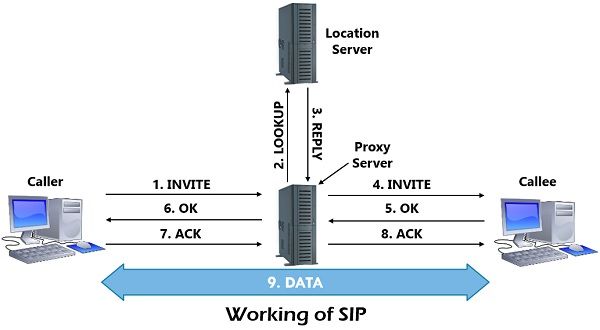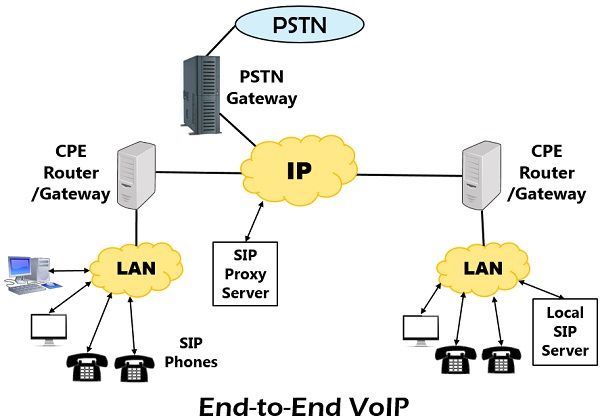 The SIP and VoIP are the technologies work for enabling any type of communication over the internet. However, the VoIP is separately used for IP telephony, but SIP is the protocol which handles the overall exchange of multimedia. More specifically, the SIP signalling protocol is the way to standardise the VoIP or IP telephony.
The SIP and VoIP are the technologies work for enabling any type of communication over the internet. However, the VoIP is separately used for IP telephony, but SIP is the protocol which handles the overall exchange of multimedia. More specifically, the SIP signalling protocol is the way to standardise the VoIP or IP telephony.
The SIP (Session Initiation Protocol) is used to set up the internet telephone calls, video conferencing and other multimedia connections. On the other hand, the Voice over IP is used to transfer the voice traffic through the data networks.
Content: SIP and VoIP
Comparison Chart
| Basis for comparison | SIP | VOIP |
|---|---|---|
| Basic | Protocol used to handle the multimedia session. | Used to establish voice calls over the internet. |
| Pertaining to | Signalling protocol to govern the technologies such as VoIP. | Separate and individually distinct technology. |
| Handles | All type of media | Voice calls and message. |
| Types of devices used | Independent of other devices. | Rely on the devices that provide connection to the internet. |
| Traffic management | Individual systems are utilized to handle different operation. | All the operations are handled by a single system. |
Definition of SIP
SIP (Session Initiation Protocol) is a group of rules that govern the multimedia exchange over the internet. The SIP is the control protocol of the application layer responsible for setting, manipulating and ending the multimedia sessions with one or more users, the multimedia session can contain any sort of multimedia, including data, voice, video, image, etcetera. In simpler terms, SIP works in a similar way as the HTTP works, where a request and response model is followed.
The entire process of the SIP protocol is explained in the steps below:
- Firstly, the SIP caller generates a request in which an invite message is sent to the callee.
- The proxy server placed between the caller and callee, examine the structure of the message body comprised of media type, format and caller’s capabilities.
- In case callee accepts the request, the reply code is sent to the caller. The callee can also send OPTIONS method to query the host about its capabilities and other information.

- After that, the connection is completed using the three-way handshaking protocol.
- Then the caller generates an ACK message to culminate the protocol and confirm the receipt of the 200 (OK) message.
- The session is terminated by sending a BYE method to either party.
SIP Components
There are generally four components of Session Initiation Protocol, which are discussed below.
- User Agents – Client and server fall under the user agent category, in which the client creates requests while server receives the requests and generate responses.
- Various Servers – There are several types of servers employed in the SIP protocol, such as proxy, location, registrar, redirect. Each server works on different criteria.
- Gateways – Gateway is nothing but a user agent which can connect to other networks, for example, PSTN.
- B2B(Business-to-Business) User Agents – Includes two user agent capable of transferring and modifying the SIP messages.
The SDP (Session Description Protocol) is used to provide the information about the call. SIP can also provide features such as call waiting, call screening, authentication and encryption. It can also place a call from an IP enabled equipment to an ordinary telephone.
Definition of VoIP
VoIP (Voice over IP) is the utilisation of IP for enabling the telephone service. The alternative name for the VoIP is the IP telephony. There are three components necessarily required for achieving VoIP (Voice over IP). Priorly, it needs a protocol like RTP to accurately transfer the digitised signal along the IP network. Secondly, it requires a mechanism to set and end the calls. At last, an isochronous network of the IP network.
Conventional systems
- Earlier the telephone system named as PSTN (Public Switched Telephone Network) work on the circuit switching, where the resources are engaged until the call is ended.
- Later, the advent of IP emerged the concept of packet switching which makes communication possible by dividing the data into small sized self-reaching packets (because it contains the destination address).
Working of VoIP
Referring to the below-given diagram, the IP telephone system is linked to the wide area IP network and LAN too. To make the voice calls locally, the LAN is used. The speech is digitised and encoded with the help of the codec device installed in the IP phones. These phones also include the functions such as packetisation and depacketization of the encoded speech.  Wide area IP network is used to make the calls between the distinct sites. IP phone registration, call signalling and coordination is done through the Proxy server. It can also provide cross-compatibility with the traditional PSTN network using VoIP gateway.
Wide area IP network is used to make the calls between the distinct sites. IP phone registration, call signalling and coordination is done through the Proxy server. It can also provide cross-compatibility with the traditional PSTN network using VoIP gateway.
Key Differences Between SIP and VoIP
- SIP manages the multimedia sessions while VoIP just enables voice call across an IP internet.
- Any type of media can be carried by SIP. In contrast, the VoIP can only send and receive the voice calls and messages.
- SIP devices are independent of other devices for its working and just require the modem. As against, the VoIP devices need a computer to make and receive calls.
- In SIP, separate functions are handled by the separate modules; this is the reason it can handle a large amount of data and traffic. On the contrary, in VoIP a single system is responsible for controlling all of the functions.
Conclusion
SIP creates a VoIP system that connects you to the phone networks. SIP is a protocol is mainly used for signalling and establishment of the internet telephone call, video conferences and other multimedia connections. On the other hand, the VIOP is used to drive the voice traffic along the IP network. The advantage of the SIP is that it can intelligently interplay with other protocols.
Vollen says
I always want to have in-depth knowledge about business and this is the site that helps me to gain useful knowledge about it.